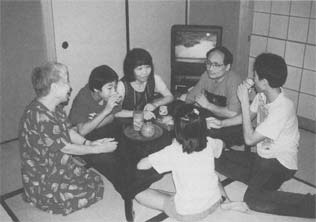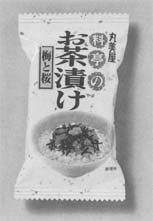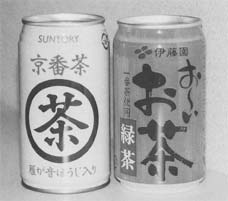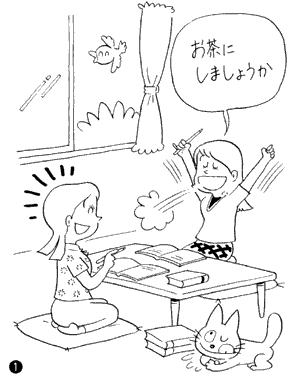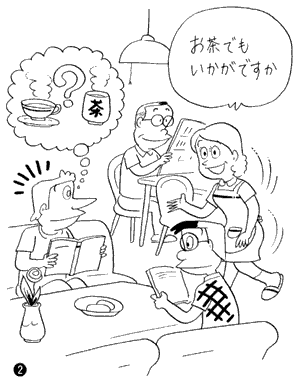In Japan, to call something "nichijō-sahanji" (literally "daily tea and rice") is to say it is an ordinary occurrence, as unremarkable as sipping green tea
or eating a meal. From this we can infer that green tea is an essential part
of everyday Japanese life. Japanese restaurants serve free green tea as a matter
of course, along with the usual glass of water.
As you probably know, people
in Japan do not ordinarily go through an elaborate ceremony just to drink
a cup of green tea. "Japanese Culture and Daily Life" in this issue takes a look at the history and background of ocha (green tea) and explores its central place in the lives of Japanese both young
and old.
The history of ocha
Tea is thought to have its origins in the mountainous
region that stretches from northeastern India to Yünnan in southwest
China. Different processing
techniques can turn the tea leaves into a variety of products--green tea, oolong
tea, or
black tea--and the brewed liquid rivals coffee in worldwide popularity.
Tea
makes
its first historical appearance in third-century Chinese literature. Originally
used for medicinal purposes, its popularity grew along with the spread of
Buddhist teachings, which prohibited alcohol. Because of the expense, however,
tea was
drunk only among the upper classes; not until the seventh century did the
consumption of tea become widespread.
The influx of Europeans and Christian missionaries in the sixteenth century
made tea one of the major trading commodities. In the early seventeenth century
the
Dutch East Indies Company was particularly instrumental in bringing tea to
the worldwide community.
The history of tea in Japan begins in the Nara period
(710-794)
when Buddhist monks and students studying in Tang-dynasty China brought seeds
back with them. When monks took their teachings to other parts of Japan, they
brought their tea with them,
and by the Kamakura period (1185-1333) tea had become a nationwide phenomenon.
Tea became an everyday drink by the Edo period (1603-1868).
Currently, over
half of Japan's green tea is produced in Shizuoka Prefecture, with cultivation
spreading
as far north as Fukushima and Niigata Prefectures. Sadō,
literally "the way of tea", developed gradually into a ceremony in which a host invited guests to converse
and connect with one another over a pot of tea. The tea ceremony, perfected
by Sen no Rikyū (1522-1591), is now practiced by several different schools. The related arts
of tearoom architecture, tea ceremony utensils and pottery, and flower arrangement
embody an aesthetic that has both influenced and transcended subsequent generations
to the present. The tea ceremony focuses on how the host processes and offers
the tea, and on how the guest accepts it. By embodying and observing the
prescribed etiquette, participants come to an understanding of themselves
and one another.
Everyday tea
The tea ceremony is not a part of the ordinary person's daily routine,
but the flavor and fragrance of tea permeates most people's daily
lives. People
look
forward to May, when the new crop of tea, shincha,
is harvested. Water too--of which Japan is blessed with an abundance--is
important in bringing out the
delicate fragrance and flavor of the new leaves.
Green tea is divided
into grades depending
on the time of harvest, the portion of the leaf used and the processing
method. One typical tea, sencha,
priced between 500 yen and 2,500 yen per 100 grams, is made
by steaming and then drying and rubbing the tea leaves. Bancha and hōjicha are popular inexpensive teas, selling for about
400 yen per 100 grams. Matcha, the tea used in tea ceremony, is made
by steaming, drying, and then powdering the tea leaves.
To drink tea, a family typically
places the tea leaves in a tea pot (kyūsu),
adds hot water, and without steeping pours the hot liquid into each person's
own tea cup. The tea cup has no handle, and no one would dream of adding
sugar or milk. Serving tea involves paying attention to the season, the
kind of tea,
the pottery, and the recipient. Guests are served a higher grade of tea.
Summer tea is served cold in a cool-looking cup. High-grade tea contains
a lot of caffeine,
so a child's portion may be watered down or made from tea with less caffeine.
Like the tea ceremony, the more casual, everyday sharing of tea is meant
to make guests feel at home. Tea is a kind of glue of family togetherness,
particularly
after dinner. Following the meal, it is often drunk by all members as they
relax together and perhaps watch TV in the living room.
Nowadays black
tea and coffee
are challenging the ascendency of green tea. Sports and nutritional drinks
are also quite popular among the young set. Still, the variety of canned
tea now
being sold in vending machines is testimony to tea's enduring popularity.
Green tea is a pick-me-upper having caffeine and vitamins C and B2. It
kills bacteria, reduces pain, alleviates fever (with tannic acid), helps
adjust
the appetite, and is low in calories. As young people discover these
healthy properties,
many of them are throwing away their newfangled refreshments in favor
of green tea and Chinese tea. This back-to-basics trend is also evident
in
innovative deserts such as matcha ice cream and cake.
The origins of "cha"
Words for "tea" in all parts of the world generally
derive from Chinese, either the Cantonese "cha" or the Fujian "te." Here is a list of words for "tea" in several languages:
| Cantonese |
cha |
| Hindi |
chae |
| Japanese |
cha, sa |
| Korean |
cha |
| Mandarin |
cha |
| Mongolian |
tsai |
| Persian |
chai |
| Russian |
chai |
| Swahili |
chai |
| Tibetan |
cha |
| Turkish |
chay |
|
| Fujian |
te |
| Dutch |
thee |
| English |
tea |
| Finnish |
tee |
| French |
thé |
| German |
tee |
| Italian |
té |
| Spanish |
té |
| |
|
| |
|
| |
|
|
Sources:
Hashimoto Minoru, ocha no
bunka: Sono sogoteki kenkyu dai ichi bu (The culture of tea: General
study, part 1),
Tankosha, 1981; Talking with Asian Friends, edited by Asian
Cultural Centre for UNESCO,1984
Consumption of tea and coffee in Japan
between 1986 and 1994
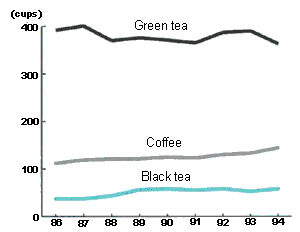
Source:
Chakankei shiryo (Resources related to tea),
Nihon chagyo chuokai, 1996
Guide to ocha on
the Internet
(Please note that all explanations are in Japanese.)
Green
site (http://www.inh.co.jp/maru7/index.html)
Pictures and explanations of products. Art gallery.
|
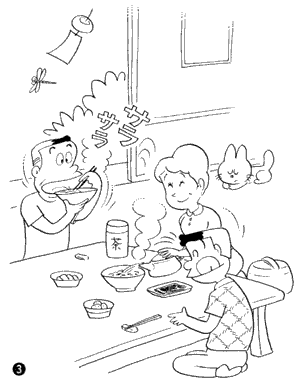
1 "Shall
we have some tea?"
Ocha not means green tea, but also
"something to drink" and "a relaxing break." If someone suggests having tea (Ocha ni shimashō ka?), they usually are simply suggesting a break, and ofteh you end up drinking
coffee or other refreshments.
At some companies the "three o'clock tea break" (sanji
no ocha) is still a tradition. Tea also comes in handy as a way of asking someone out: "Won't you have some tea with me?" (Chotto ocha demo shimasen ka?). For a time, a fashionable pick-up line among students was "How about some tea?" (ocha shinai?).
2 "Would you like some tea?"
Here ocha means "something to drink," and
this question will likely be followed by "What will you have?" (Nani ga ii desu ka?).
3 ochazuke
Pouring tea over
rice was originally developed as a way of making a warm meal from leftovers.
Now many people also add nori (seaweed),
salted salmon, and umeboshi (pickled plum), among other spices. It's an easy-to-make light
meal or a late-night
snack.
Illustrations: Iizuka Yoshiteru
|


